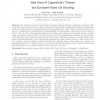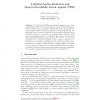59 search results - page 4 / 12 » Parallel Lattice Basis Reduction |
98
Voted
ARITH
2007
IEEE
15 years 4 months ago
2007
IEEE
We address the problem of computing a good floating-point-coefficient polynomial approximation to a function, with respect to the supremum norm. This is a key step in most process...
155
Voted
GLOBECOM
2006
IEEE
15 years 6 months ago
2006
IEEE
— Lattice basis reduction is a powerful technique that enables a hard-output detector for a multiple-input multiple-output channel to approach maximum-likelihood performance with...
111
Voted
CORR
2010
Springer
14 years 11 months ago
2010
Springer
: We develop a framework for solving polynomial equations with size constraints on solutions. We obtain our results by showing how to apply a technique of Coppersmith for finding ...
120
Voted
ANTS
2010
Springer
15 years 4 months ago
2010
Springer
Lattices over number
elds arise from a variety of sources in algorithmic algebra and more recently cryptography. Similar to the classical case of Z-lattices, the choice of a nice,...
119
click to vote
CRYPTO
2007
Springer
15 years 7 months ago
2007
Springer
To date the NTRUEncrypt security parameters have been based on the existence of two types of attack: a meet-in-the-middle attack due to Odlyzko, and a conservative extrapolation of...


